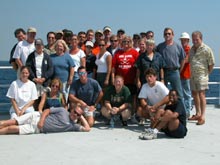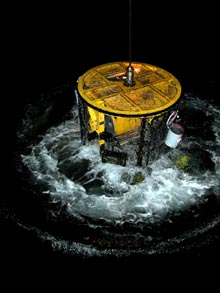
The entire Deep Sea Medicines 2003 crew aboard the NOAA Ship Ronald H. Brown. Click image for larger view.
Marine Science: A Multidisciplinary Endeavor
September 19, 2003
Gary K. Wolfe
Marine and Environmental Education
Eau Gallie High School
Rollins College, Brevard, FL
My experience aboard the NOAA Ship Ronald H. Brown is about to come to an end. It has been almost 11 days since I boarded the ship as part of NOAA's Educator at Sea program, and I must say that this experience was a reminder of the hard work, frustration, dedication and satisfaction of field research. I have not done anything like this since the mid-1980s, when I was unmarried and had no family responsibilities. I have participated in research projects since then, but none that required me to be away from my family for an extended period of time.
I have to give the Harbor Branch Oceanographic Institution (HBOI) scientists and the NOAA Office of Ocean Exploration staff a lot of credit. From discussions with them over the past 10 days I learned that they are "away" almost as often as they are at home. It is a difficult life that requires real dedication to the work. A nine-to-five job and everyday family life are not part of the picture for most research scientists. The satisfaction of doing good research, however, and the desire to leave the world a better place than it was when one arrived, are the dividends of pursuing scientific research.
From a professional educator's perspective, this trip has validated a growing approach to marine science education. Even though the expedition was primarily biological, any true field science has to examine the subject being investigating from a multidisciplinary approach. Biology does not work all by itself. To understand biology, you have to understand chemistry, and understand chemistry, you have to understand physics. And so forth.
In my 18 years as a marine science educator it has always seemed natural to me to integrate these core sciences into the marine science curriculum. I guess I have to take my hat off to my Florida Tech professors for having the foresight to make sure that all of us marine science majors had a well-rounded education in all of these related disciplines.
Since marine science is a truly integrated science, learning about Ekman spirals is just as important as learning about plankton. The scientists have had to understand many, many factors in addition to the biological ones. Bottom topography, substrate types, currents, temperature, pressure, turbidity, and salinity are just a few examples of the abiotic (nonliving) parameters that they had to consider as they searched for useful biomedical compounds in the deep sea.
I know that this experience will have a positive influence on what and how I teach my students. I highly recommend NOAA's Ocean Exploration program and the NOAA Teacher-at-Sea program to marine science educators. These programs put teachers in touch with the realities of marine research.
I would personally like to thank the HBOI scientists, the crews from Sonsub Inc. and C&C Technologies, the crew of the NOAA Ship Ronald H. Brown, and most of all the NOAA OE team and the Teacher-at-Sea coordinators for the opportunity to participate in such an important and enlightening project. Your patience and knowledge will serve me well in the classroom and among my colleagues for many years to come.
Sign up for the Ocean
Explorer E-mail Update List.






















